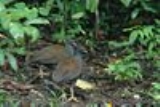
Orange-footed Scrubfowl
Encyclopedia
The Orange-footed Scrubfowl, Megapodius reinwardt, is a small megapode of the family Megapodiidae.
This species comprises five subspecies found on many islands in Wallacea
as well as southern New Guinea
and northern Australia
. It is a terrestrial bird the size of a domestic chicken and dark-coloured with strong orange legs and a pointed crest at the back of the head. It utilises a range of forest and scrub habitats and has colonised many small islands throughout its range. In general, populations seem to be stable and the conservation status of the species is considered to be of Least Concern
.
The Orange-footed Scrubfowl feeds on seeds, fallen fruit and terrestrial invertebtrates. As with other megapodes, it nests in large mounds of sand, leaf litter and other debris where the heat generated by the decomposition of organic material serves to incubate the eggs. Construction and maintenance of the mounds, which may reach 4.5 m in height and 9 m in diameter, takes place throughout the year.
Some of the subspecies may be treated as full species, such as the Tanimbar Scrubfowl
(Megapodius tenimberensis), while other subspecies may be conidered subspecies of other species (i.e. buruensis is sometimes considered a subspecies of the Dusky Megapode).
This species comprises five subspecies found on many islands in Wallacea
Wallacea
Wallacea is a biogeographical designation for a group of Indonesian islands separated by deep water straits from the Asian and Australian continental shelves. Wallacea includes Sulawesi, the largest island in the group, as well as Lombok, Sumbawa, Flores, Sumba, Timor, Halmahera, Buru, Seram, and...
as well as southern New Guinea
New Guinea
New Guinea is the world's second largest island, after Greenland, covering a land area of 786,000 km2. Located in the southwest Pacific Ocean, it lies geographically to the east of the Malay Archipelago, with which it is sometimes included as part of a greater Indo-Australian Archipelago...
and northern Australia
Australia
Australia , officially the Commonwealth of Australia, is a country in the Southern Hemisphere comprising the mainland of the Australian continent, the island of Tasmania, and numerous smaller islands in the Indian and Pacific Oceans. It is the world's sixth-largest country by total area...
. It is a terrestrial bird the size of a domestic chicken and dark-coloured with strong orange legs and a pointed crest at the back of the head. It utilises a range of forest and scrub habitats and has colonised many small islands throughout its range. In general, populations seem to be stable and the conservation status of the species is considered to be of Least Concern
Least Concern
Least Concern is an IUCN category assigned to extant taxon or lower taxa which have been evaluated but do not qualify for any other category. As such they do not qualify as threatened, Near Threatened, or Conservation Dependent...
.
The Orange-footed Scrubfowl feeds on seeds, fallen fruit and terrestrial invertebtrates. As with other megapodes, it nests in large mounds of sand, leaf litter and other debris where the heat generated by the decomposition of organic material serves to incubate the eggs. Construction and maintenance of the mounds, which may reach 4.5 m in height and 9 m in diameter, takes place throughout the year.
Some of the subspecies may be treated as full species, such as the Tanimbar Scrubfowl
Tanimbar Scrubfowl
The Tanimbar Megapode or Tanimbar Scrubfowl, Megapodius tenimberensis, is a small megapode endemic to the Tanimbar Islands of Indonesia...
(Megapodius tenimberensis), while other subspecies may be conidered subspecies of other species (i.e. buruensis is sometimes considered a subspecies of the Dusky Megapode).

